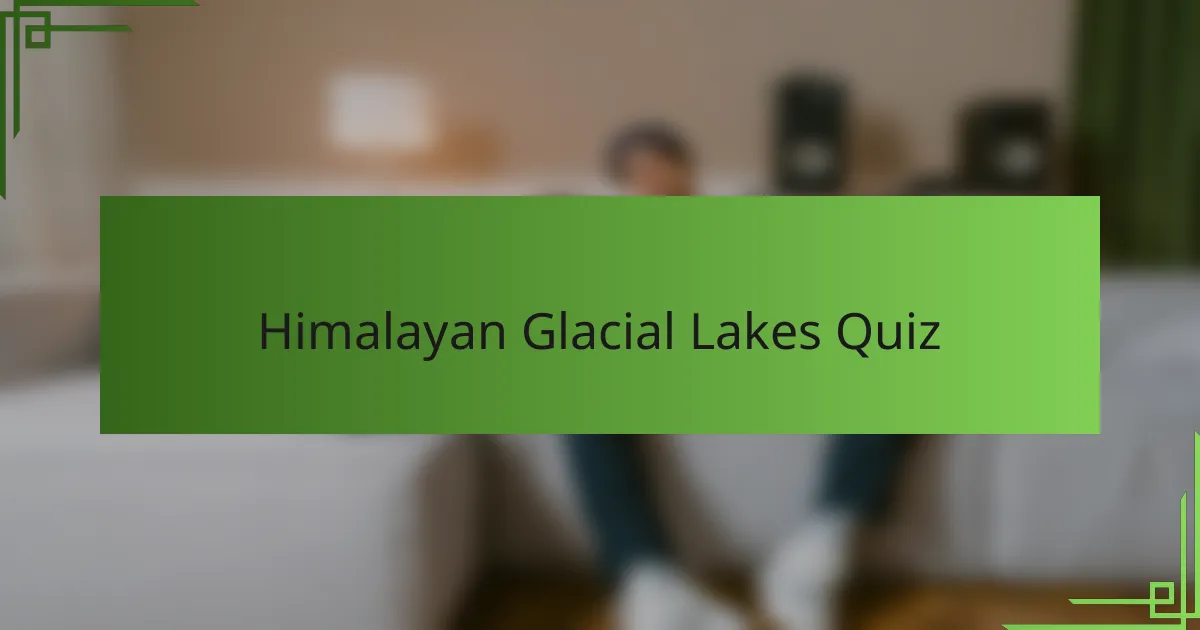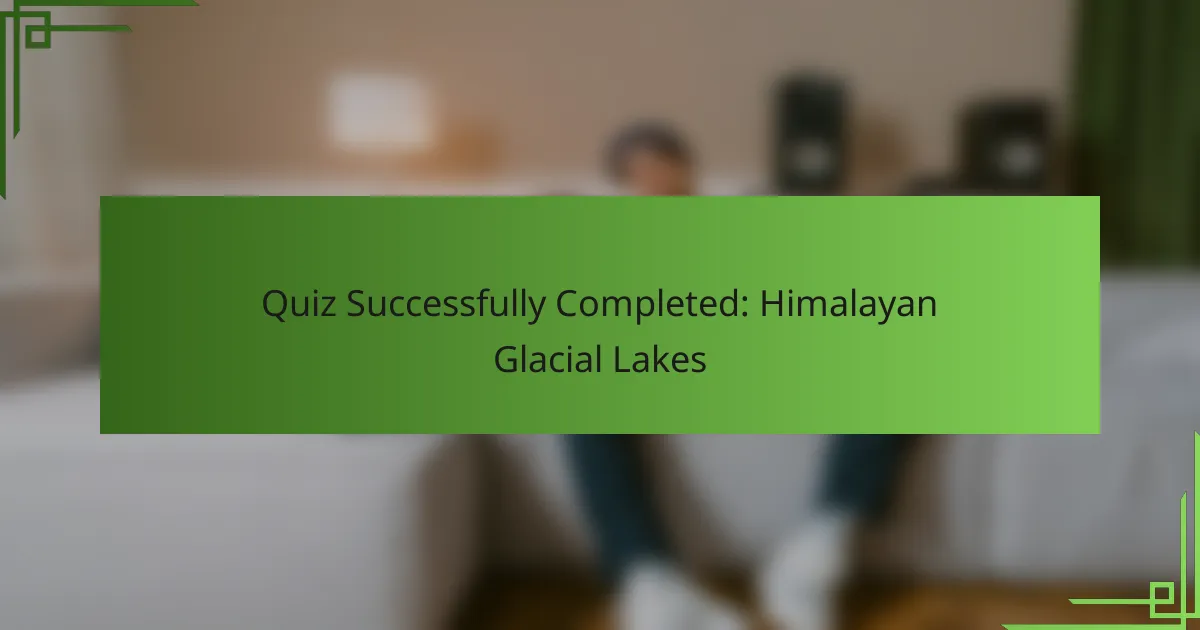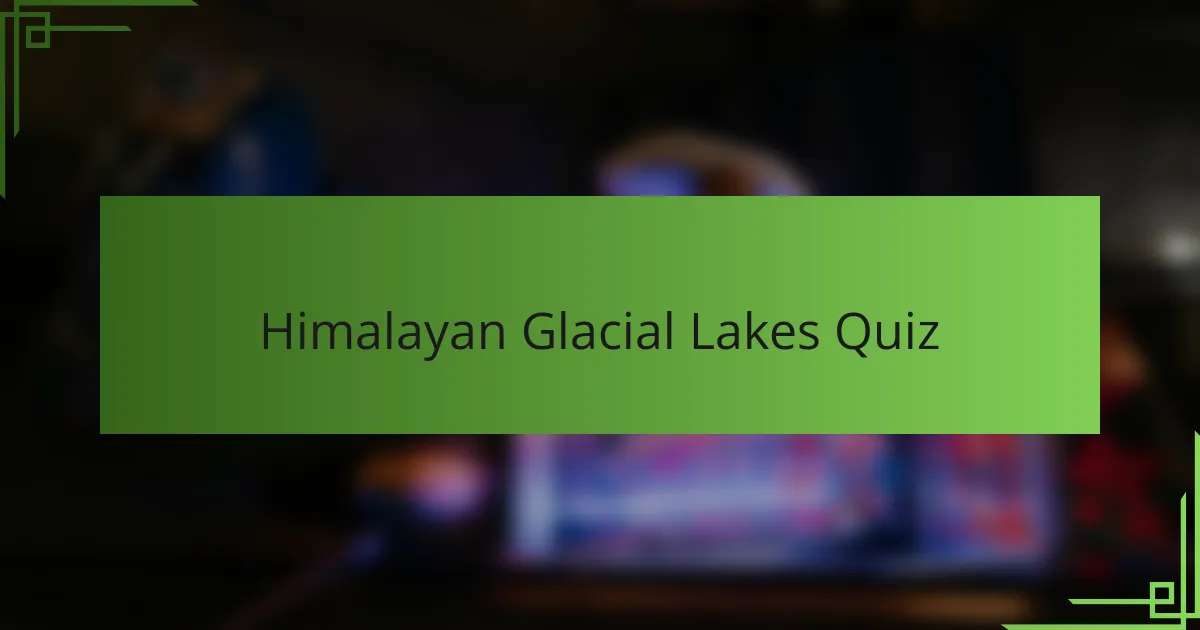
Himalayan Glacial Lakes Quiz
1. Which Himalayan glacial lake is known as the highest lake in the world?
- Gurudongmar Lake
- Roopkund Lake
- Pangong Tso
- Lake Tilicho
2. Name the largest freshwater glacial lake located in the Indian Himalayas.
- Wular Lake
- Chandratal Lake
- Dal Lake
- Pangong Tso
3. What is the prominent glacial lake situated near the base of Mount Everest?
- Rara Lake
- Loktak Lake
- Tilicho Lake
- Gokyo Lake
4. Which Himalayan country is home to the famous Renjo Lake?
- Nepal
- India
- Bhutan
- Tibet
5. The Gurudongmar Lake is found in which Himalayan state of India?
- Himachal Pradesh
- Sikkim
- Arunachal Pradesh
- Uttarakhand
6. Which Himalayan glacial lake is known for its striking turquoise blue water and is a sacred site for local communities?
- Gurudongmar Lake
- Pangong Lake
- Roopkund Lake
- Tso Moriri Lake
7. What is the name of the lake formed by glacial meltwater in the Annapurna region of Nepal?
- Lake Rara
- Lake Tilicho
- Lake Phoksundo
- Shey Phoksundo Lake
8. Which Himalayan peak’s glacier melt feeds into the Tso Moriri Lake in India?
- Mount Nun
- Mankorma Peak
- Kang Yatze
- Stok Kangri
9. Which Himalayan glacial lake was formed as a result of a massive landslide blocking a valley?
- Pangong Lake
- Tso Moriri
- Rara Lake
- Sarez Lake
10. The Pangong Tso Lake, which is a notable Himalayan glacial lake, lies between India and which other country?
- China
- Pakistan
- Bhutan
- Nepal
11. Which glacial lake in the Himalayas has been the focus of environmental studies due to its increasing size from climate change?
- Pangong Lake
- Imja Lake
- Gurudongmar Lake
- Tso Moriri Lake
12. What is the name of the glacial lake that lies in the vicinity of the Kanchenjunga mountain?
- Tso Lhamo Lake
- Gurudongmar Lake
- Sinialchu Tso
- Cho La Lake
13. Hemkund Lake, a glacial lake in the Himalayas, is located in which Indian state?
- Arunachal Pradesh
- Himachal Pradesh
- Uttarakhand
- Sikkim
14. Which Himalayan glacial lake is renowned for its association with the Nanda Devi mountain?
- Gosaikunda Lake
- Hemkund Lake
- Sat Tal Lake
- Roopkund Lake
15. The Kyagar Tso lake is a Himalayan glacial lake found in which region?
- Bhutan
- Ladakh, India
- Sikkim, India
- Nepal

Quiz Successfully Completed: Himalayan Glacial Lakes
Congratulations on completing the quiz on Himalayan Glacial Lakes! By engaging with these questions, you have deepened your understanding of the unique geography and formation processes of these remarkable natural features. You likely discovered how glacial lakes are influenced by climate, topography, and environmental changes in the Himalayan region.
Through this quiz, you may also have gained insights into the ecological significance of these lakes and the challenges they face, such as glacial melt and potential flooding risks. Recognizing these factors is essential for appreciating the complexity of mountain geography and the delicate balance of natural systems in high-altitude environments.
We invite you to explore the next section on this page, where you will find detailed information about Himalayan Glacial Lakes. This resource will expand your knowledge further, offering case studies, geographic data, and discussions on ongoing conservation efforts. Continue your journey to better understand these fascinating geographic phenomena and their critical role in our planet’s ecosystems.

Himalayan Glacial Lakes
Overview of Himalayan Glacial Lakes
Himalayan glacial lakes are bodies of water formed by the melting of glaciers in the Himalayan mountain range. These lakes result from glacial activity, where meltwater accumulates in depressions or behind moraines left by retreating glaciers. The Himalayas, spanning across Nepal, Bhutan, India, China, and Pakistan, contain thousands of such lakes. Their formation is influenced by climatic conditions and geological processes unique to high-altitude environments. Notable examples include Gokyo Lakes in Nepal and Tsho Rolpa in Tibet.
Geographical Distribution of Himalayan Glacial Lakes
The distribution of Himalayan glacial lakes aligns with the extent of contemporary and former glaciers within the mountain range. These lakes are predominantly concentrated in Nepal’s Sagarmatha and Karnali regions, Tibet’s trans-Himalayan zones, and northern Indian states like Uttarakhand and Sikkim. Their locations typically correspond to high elevations above 4,000 meters where glaciation is extensive. Geographic characteristics such as valley orientation, slope, and elevation significantly govern the formation and persistence of these lakes.
Formation Processes of Himalayan Glacial Lakes
Himalayan glacial lakes primarily form through two processes: moraine damming and ice damming. When glaciers retreat, they deposit moraines—ridges of unconsolidated debris—that can trap meltwater, creating moraine-dammed lakes. Alternatively, ice dams form when glacier ice obstructs valleys, forming temporary lakes. Over time, as glaciers continue melting, these lakes can expand. The dynamic nature of glacier fluctuations in the Himalayas is critical to the ongoing creation and evolution of these lakes.
Hydrological Characteristics of Himalayan Glacial Lakes
These lakes exhibit unique hydrological traits shaped by their glacial origins and high-altitude environment. They receive inputs mainly from snowmelt and glacial meltwater, resulting in cold, oligotrophic waters with low nutrient content. Seasonal variation strongly affects their water levels, influenced by monsoon-driven precipitation and temperature changes. Lakes such as Tsho Rolpa in Nepal demonstrate significant water level fluctuations, impacting downstream river systems like the Sun Kosi Basin.
Geohazards Related to Himalayan Glacial Lakes
Himalayan glacial lakes pose significant geohazard risks, primarily through Glacial Lake Outburst Floods (GLOFs). These floods occur when natural dam structures, like moraines, fail due to overtopping or seismic activity, releasing vast volumes of water rapidly. GLOFs have resulted in devastating downstream impacts in regions such as the Langtang Valley in Nepal. Monitoring organizations, including the International Centre for Integrated Mountain Development (ICIMOD), track changes in these lakes to mitigate hazard potential and support disaster preparedness efforts.
What are Himalayan glacial lakes?
Himalayan glacial lakes are bodies of water formed by melting glaciers in the Himalayan mountain range. They typically develop when glacier meltwater accumulates in depressions or behind moraines left by retreating glaciers. These lakes are common in the Himalayas due to the extensive glaciation and ongoing climate change, which causes glacier retreat and melting, increasing lake formation. For example, the Tsho Rolpa lake in Nepal was formed from glacier melt and has grown significantly over the past decades due to glacier retreat documented by scientific studies.
How do Himalayan glacial lakes form?
Himalayan glacial lakes form primarily through glacier retreat and melting. As glaciers in the Himalayas recede due to rising temperatures, meltwater accumulates in front of the glaciers or is trapped by natural barriers like moraines composed of rock and debris. This process creates lakes that grow as more ice melts. Satellite images and field observations from institutions like the International Centre for Integrated Mountain Development (ICIMOD) confirm that glacier retreat over recent decades has directly led to the formation and expansion of these lakes.
Where are the major Himalayan glacial lakes located?
The major Himalayan glacial lakes are primarily located in Nepal, Bhutan, India, and the Tibet Autonomous Region of China. Notable examples include Tsho Rolpa and Imja Tsho in Nepal, which are among the largest and most studied. These lakes lie at high altitudes, often above 4,000 meters, in the trans-Himalayan region. Geographic surveys and remote sensing data identify these locations consistently, with Nepal hosting the highest number of such lakes due to its extensive glaciation.
When did the Himalayan glacial lakes begin to significantly increase in size?
The significant increase in the size of Himalayan glacial lakes began primarily in the late 20th century and continues into the 21st century. This trend corresponds with accelerated glacier retreat linked to regional warming observed since the 1980s. Climate data from the Hindu Kush Himalayan Monitoring and Assessment Program (HIMAP) confirm increased temperatures and glacier melting, leading to the expansion of lakes such as Tsho Rolpa and others, which have doubled or tripled their size in recent decades.
Who monitors and studies Himalayan glacial lakes?
Himalayan glacial lakes are monitored and studied by international and regional institutions including ICIMOD (International Centre for Integrated Mountain Development), the Geological Survey of India, and the Chinese Academy of Sciences. These organizations use satellite imagery, field surveys, and hydrological modeling to track lake changes, assess risks of glacial lake outburst floods (GLOFs), and understand climate impacts. Their research provides critical data for disaster risk reduction and environmental management in the Himalayan region.
